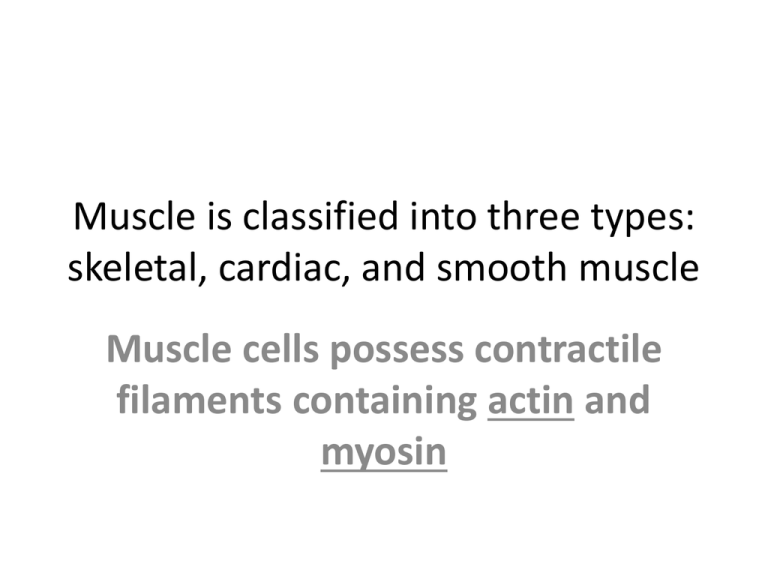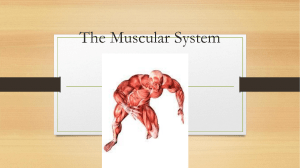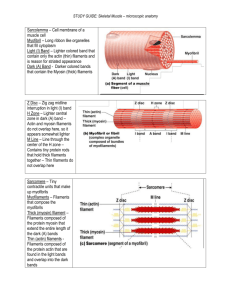Histology of muscle ppt.
advertisement

Muscle is classified into three types: skeletal, cardiac, and smooth muscle Muscle cells possess contractile filaments containing actin and myosin • Structure of Skeletal Muscle • 1. Types of skeletal muscle cells include red (slow), white (fast), and intermediate. All three types may be present in a given muscle. • 2. These three types vary in their content of myoglobin, number of mitochondria, concentration of various enzymes, and rate of contraction • • • • • • • • • • Red (slow; type 1) High - Myoglobin Many -Mitochondria High in oxidative enzymes; low in ATPase Contraction -Slow but repetitive; not easily fatigued Intermediate (type 2A) Intermediate-Myoglobin Intermediate-Mitochondria Intermediate in oxidative enzymes and ATPase Contraction-Fast but not easily fatigued • • • • White (fast; type 2B) Low -Myoglobin Few -Mitochondria Low in oxidative enzymes;high in ATPase and phosphorylases • Fast and easily fatigued • Connective tissue • 1. Epimysium surrounds an entire muscle. • 2. Perimysium surrounds fascicles (small bundles) of muscle cells. • 3. Endomysium surrounds individual muscle cells and is composed of reticular fibers and an external lamina. • Skeletal muscle cells are long, cylindrical, multinucleated cells that are enveloped by an external lamina and reticular fibers. • Their cytoplasm is called sarcoplasm, and their plasmalemma is called the sarcolemma • and forms deep tubular invaginations, or T (transverse) tubules, which extend into the cells. The muscle cells possess cylindrical • collections of myofibrils, 1-2 micrometers (pm) in diameter, which extend the entire length of the cell. • Myofibrils are longitudinally arranged, cylindrical bundles of thick and thin myofilaments • Skeletal muscle cross-striations • A bands: They contain both thin and thick filaments, which overlap. • Six thin filaments surround each thick filament • I bands : They contain only thin filaments. • H bands are light regions transecting A bands; they consist of thick filaments only. • M lines are narrow, dark regions at the center of H bands • Z disks (lines) are dense regions bisecting each I band • Z disks contain a-actinin, which binds to thin filaments Molecular organization of myofilaments • Thin filaments are composed of F-actin, tropomyosin, troponin, and associated proteins. • a. F-actin is a polymer of G-actin monomers arranged in a double helix. • (1) Each monomer possesses an active site that can interact with myosin. • (2) F-actin is present as filaments (with a diameter of 5 nm) that exhibit • polarity, having a (+) and (-) end. • Tropomyosin molecules are 41 nm in length. They bind head-totail, forming filaments that are located in the grooves of the F-actin helix. • Troponin is associated with each tropomyosin molecule and is composed • of: • (1) Troponin T (TnT), which forms the tail of the molecule and functions in binding the troponin complex to tropomyosin. • (2) Troponin C (TnC), which possesses four binding sites for calcium. • (3) Troponin I (TnI), which binds to actin, inhibiting interaction of • myosin and actin. • Thick filaments each contain about 250 myosin molecules arranged in an antiparallel fashion and three associated proteins—myomesin, titin,and C protein. • a. Myosin is composed of two identical heavy chains and two pairs of light chains. • (1) Myosin heavy chains consist of a long rod-like "tail" and a globular "head." The tails of the heavy chains wind around each other in an a-helical configuration. • (a) Tails function in the self-assembly of myosin molecules into bipolar thick filaments. • (b) Actin-binding sites of the heads function in contraction. • (2) Myosin light chains are of two types; one molecule of each type is associated with the globular head of each heavy chain. • The sarcomere is the regular repeating region between successive Z disks and constitutes the functional unit of contraction in skeletal muscle. • The sarcoplasmic reticulum (SR) is a modified smooth endoplasmic reticulum (SER) that surrounds myofilaments and forms a meshwork around each myofibril. • The SR forms a pair of dilated terminal cisternae, which encircle the myofibrils at the junction of each A and I band. • It regulates muscle contraction by sequestering calcium ions (leading to relaxation) or releasing calcium ions (leading to contraction). • Triads are specialized complexes consisting of a narrow central T tubule flanked on each side by terminal cisternae of the SR. They are located at the A-I junction in mammalian skeletal muscle cells and help provide uniform contraction throughout the muscle cell. Cardiac Muscle • General features • 1. Contract spontaneously and display a rhythmic beat. • 2. Contain one (occasionally two) centrally located nuclei. • 3. Contain glycogen granules, especially at either pole of the nucleus. • 4. Possess thick and thin filaments arranged in poorly defined myofibrils. Structural components of cardiac muscle cells • 1. T tubules are larger than those in skeletal muscle and are lined by external lamina. They invaginate at Z disks, not at A-I junctions as in skeletal muscle. • 2. SR is poorly defined and contributes to the formation of dyads, each of which consists of one T tubule and one profile of SR. • 3. Mitochondria are more abundant than in skeletal muscle; they lie parallel to the I bands and often are adjacent to lipids. • 4.Atrial granules are present in the atrial cardiac muscle cells and contain the precursor of atrial natriuretic peptide, which acts to decrease resorption of sodium and water in the kidneys, reducing body fluid volume and blood pressure. • 5. Intercalated disks are complex step-like junctions forming end-to-end attachments between adjacent cardiac muscle cells.









